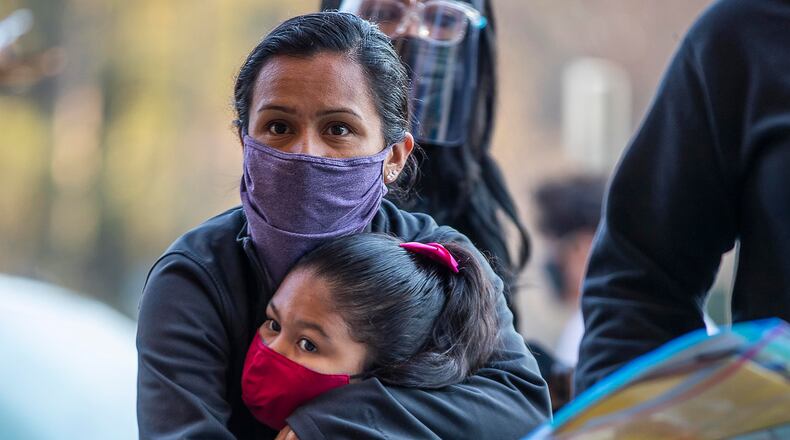In updated COVID-19 guidance released Friday, the Centers for Disease Control and Prevention now says students can be 3 feet apart in classrooms, rather than 6 feet, as long as masks are worn. That may be a relief to Georgia districts struggling — and sometimes failing — at keeping children the 6 feet apart that the Atlanta-based agency had advised.
The CDC cites three studies published in Friday’s Morbidity and Mortality Weekly Report that say, in addition to mask wearing, the reduced distancing is possible if other prevention measures are also taken.
The CDC update reflects the Biden’s Administration’s desire for schools to reopen and stay open, a goal backed by the announcement this week of $122 billion in federal relief to K-12 schools. In a media call Wednesday, Secretary of Education Miguel Cardona said, “This spring, we’re wanting to see schools reopen.”
The new guidance is significant because schools must currently limit attendance or find more space in order to keep desks 6 feet apart, said noted Brown University economist Emily Oster, who has been crunching COVID-19 data volunteered by schools. The emerging data on physical distancing will indicate whether classrooms can go with 3 feet of space, she said at a press briefing last week, “or do we need to expand buildings to be twice as big in order to get everyone back in school?”
Halving the physical distance guideline is a boon to districts reassembling classrooms after nearly a year of remote learning, including Atlanta Public Schools, which began bringing students back in late January. “The guidance would certainly enhance our capacity to bring even more students back into our buildings for face-to-face instruction,” said APS superintendent Lisa Herring.
Credit: Alyssa Pointer / Alyssa.Pointer@ajc.com
Credit: Alyssa Pointer / Alyssa.Pointer@ajc.com
While distancing requirements will ease classroom configurations, Angela Palm, director of policy and legislative services for the Georgia School Boards Association, said, “It’s important to note that the change in distance is with universal and correct wearing of masks, and the 6 feet apart still applies when eating and some other activities.”
Some education groups applauded the clarified guidance. The update “will provide additional reassurances of safety and greater capacity for students in classrooms – particularly as many Georgia districts have already returned to in-person instruction,” said Craig Harper, executive director of the Professional Association of Georgia Educators.
But not everyone is reassured.
“I don’t think any of us actually knows the proper antidote to mitigate this virus; the standards keep changing,” said Verdaillia Turner, president of the Georgia Federation of Teachers.
Lisa Morgan, president of the Georgia Association of Educators, worries reducing the recommendation to 3 feet will result in no physical distancing in some classrooms, increasing the risk of spread. While most Georgia districts have long returned to in-person schooling, some still don’t mandate masks.
“As we move toward more educators being vaccinated, we urge everyone to continue to implement the full range of mitigation strategies with fidelity – universal facemasks, appropriate physical distancing, appropriate cleaning and hygiene, improved ventilation, and isolation, testing, and contract tracing when necessary,” Morgan said.
Parents and teachers have long complained schools were often unable to enforce the 6-feet guidance.
In DeKalb County, an educators group has been critical of the district for not adhering to other CDC advice.
“It means, once again, the district will do what they want without regard to what the CDC says. The impact to teachers and students will not change,” said Deborah Jones, president of the Organization of DeKalb Educators.
Credit: Alyssa Pointer / Alyssa.Pointer@ajc.com
Credit: Alyssa Pointer / Alyssa.Pointer@ajc.com
District officials dispute those claims, saying DeKalb Schools has followed CDC guidance and public health experts “since the onset” of the pandemic and continues to follow mitigation strategies to reduce COVID spread, including mask wearing.
The National Education Association wants more detail about the rationale for the change. “We are concerned that the CDC has changed one of the basic rules for how to ensure school safety without demonstrating certainty that the change is justified by the science and can be implemented in a manner that does not detract from the larger long-term needs of students,” said NEA President Becky Pringle.
Staff writer Ty Tagami contributed to this story.
About the Author
Keep Reading
The Latest
Featured



